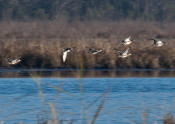View Programs and Tools which may be Utilized for Mitigation Bank Development
Who can Create a Mitigation Bank?
Mitigation banking can be a successful tool for replacing wetland and habitat function lost as the result of development activities. Creating a mitigation bank is a complex process. Ideal candidates are large properties and those where enhancement of quality wetland habitat can be planned well in advance of the mitigated impacts to wetlands. A developer may be interested in establishing its own mitigation bank when multiple projects are planned which will unavoidably impact wetlands under the jurisdiction of the USACE.
A considerable financial and management commitment is required prior to the release of any credits. Due to the investment of time and cost required, most banks in Texas are hundreds of acres in size. However, one conservation bank reviewed was a mere 20 acres.
| Which wetlands are under the jurisdiction of the USACE? In general, jurisdictional wetlands demonstrate a connection, or “significant nexus”, to what are legally described as “Waters of the U.S.” Determinations are made on a case-by-case basis. http://www.usace.army.mil/Missions/CivilWorks/RegulatoryProgramandPermits/juris_info.aspx |
Interested in Developing a Mitigation Bank on your Property?
The site must be protected by a legal instrument such as a conservation easement. Ongoing monitoring and long-term maintenance will be required. A bank sponsor is legally responsible for ensuring all the terms of the approved bank instrument have been met. The entire process is vetted and monitored by the Mitigation Banking Review Team hosted by US Army Corps of Engineers (USACE). Contractors can provide wetland delineations to determine the boundaries between wetland and upland, draft proposals and plan mitigation banks. Working with the USACE Interagency Review Team early in the development process is highly recommended.
Costs for developing the bank will depend on many factors including land prices, the acreage of the bank, the type of mitigation work, and the type of wetlands being restored. After the required documentation has been submitted and verified as complete, USACE approval for the mitigation bank can take between 225 and 330 days. Upon approval of the mitigation bank’s plan, a portion of the projected credits may be released, with more made available as milestones specified in the approved credit release schedule are met. The market value for credit varies with demand, location, and type of credit. Credits can be used for a developer’s own projects, or sold to other developers for mitigation of their project impacts.
It should be noted that conservation projects that utilize federal grants and funds cannot be used for mitigation banking or to satisfy of Clean Water Act Section 404 permits. However, if portions of the conservation project are added using non-federal money, those portions can be used for mitigation banking. For example, when a grant requires a 50% match from the landowner, any improvements provided by the landowner over and above those required for federal funding could be used as compensatory mitigation credits.
| “Section 404 of the Clean Water Act (CWA) establishes a program to regulate the discharge of dredge or fill material into waters of the US, including wetlands.”
United States Environmental Protection Agency (EPA)
|
Learn about Mitigation Bank Management and Development from the Experts
Programs and Tools which may be Utilized for Mitigation Bank Development
Click on a program below to learn more
Mitigation Bank Credit: Landowners/Developers and Aggregators
Various Private and Nonprofit Entities Creating a Mitigation Bank Basic process for developing your own mitigation bank: Planning Pre-prospectus meeting with the US Army Corps of Engineers (USACE) Submission of draft prospectus for review by USACE. If USACE finds the prospectus feasible, it will be sent out on public notice for comment. Review by federal, state, and local agencies and general public Mitigation Bank Review Team assessment Mitigation bank instrument development – legal document for the bank Mitigation bank instrument is sent out for public notice Bank approval… Read More →
Landowner Incentive Program
Texas Parks and Wildlife Department Landowner Incentive Program (LIP) The Landowner Incentive Program (LIP) is a voluntary conservation program administrated by Texas Parks and Wildlife Department and funded through the US Fish and Wildlife Service (USFWS) Partners for Fish and Wildlife Program, National Fish and Wildlife Foundation, and others. LIP provides financial assistance to landowners who wish to implement conservation practices, particularly for activities benefiting rare or at-risk species and valuable riparian areas and watersheds. LIP is a reimbursement program. Landowners will receive payment upon completion of the… Read More →



